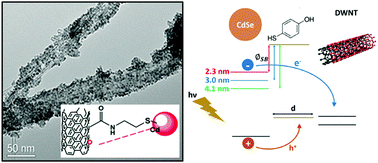Metal chalcogenide quantum dot-sensitized 1D-based semiconducting heterostructures for optical-related applications
Abstract
In terms of understanding and tuning the optoelectronic behavior of 3rd generation solar cells, such as quantum dot (QD)-sensitized solar cells, QD-based heterostructures represent an excellent and relevant model system and opportunity for analyzing exciton dissociation and charge separation across a well-defined nanoscale interface. In particular, because QDs possess a tunable bandgap and the capability of initiating multi-electron exciton generation, QD-based components tend to be incorporated within optical-related devices, including photovoltaics, light emitting diodes, photoelectrochemical devices, photosensors, and phototransistors. The community has collectively expended significant effort in terms of creating, formulating, and optimizing novel forms of heterostructures comprised of QDs, immobilized by predominantly chemical means onto one-dimensional (1D) motifs, such as but not limited to carbon nanotubes (CNTs) and carbon nanofibers (CNFs). In so doing, it has been noted that key physical variables such as but not limited to (a) QD size, (b) QD loading and coverage, as well as (c) ligand identity can impact upon optoelectronic behavior of CNT-based heterostructures. In recent years, work has extended towards analyzing the optoelectronic ‘cross-communication’ between QDs with related, adjoining 1D semiconducting metal oxides, metal chalcogenides, and metal fluorides. In these examples, other important factors that also are relevant for determining the optical properties of these more generalized classes of heterostructures include parameters, such as (i) morphology, (ii) surface coverage, (iii) chemical composition of the underlying platform, (iv) QD identity, (v) luminescence properties of activating species, as well as (vi) the identity and concentration of dopant ions. In other words, to alter, manage, and manipulate the charge versus energy transfer channels within these materials in a deterministic manner requires basic insights into the close correlation and interplay between physical structure, chemical bonding, and observed performance.



 Please wait while we load your content...
Please wait while we load your content...
